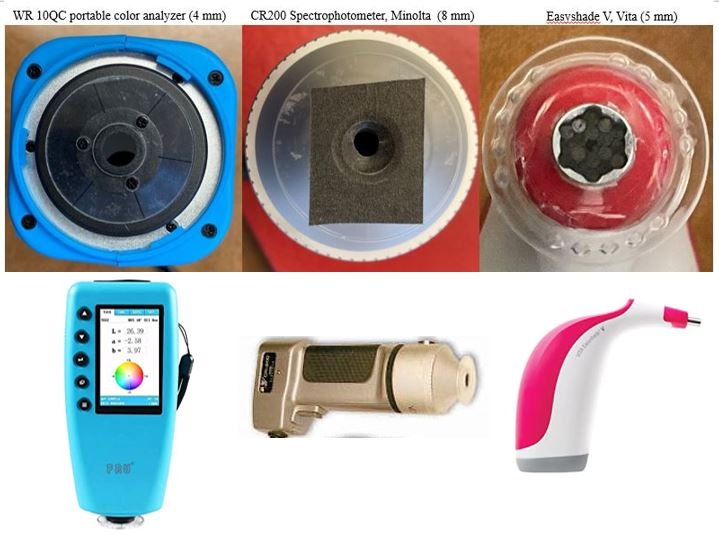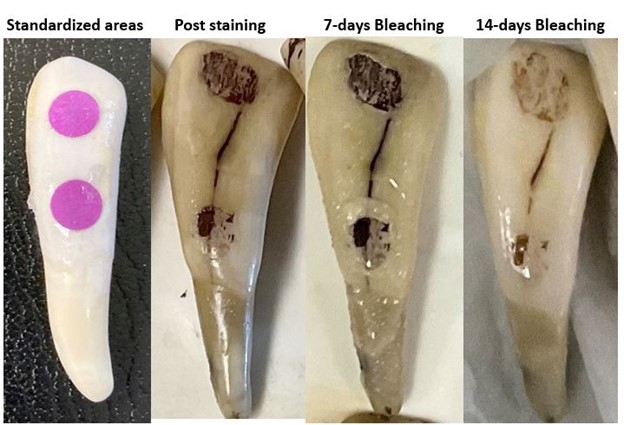IADR Abstract Archives
Comparison of Spectrophotometric and Colorimetric Shade Determination of Bovine Teeth During Bleaching Protocol
Objectives: The aim of the study is to compare the differences among three colorimetric methods evaluating color changes during a bleaching protocol.
Methods: Color assessment was completed with a Minolta CR200 Chroma Meter (C), a WR-10QC colorimeter (W), and a Vita Easyshade V (V). Each colorimeter was calibrated per manufacturer's instructions (Figure 1). To control interpersonal variability, each device was assigned to the same operator for all measurements. The detecting probe was placed as close to the stained surface as possible. The values of L*, a*, and b* were obtained for each period. A total of 1260 readings from both facial and cervical areas were obtained for comparison (Figure 2). The color difference (ΔE) was be calculated by the following equation:
ΔE = [(ΔL)2+ (Δa)2 + (Δb)2]1/2. Data set from C reading was selected as the gold standard and other values are compared to it using paired t test (α = 0.05).
Results: The pair t test showed significant differences between C and W groups (α >0.05). Cervical readings displayed greater variability because of natural curvature. V records L*C*H* values as deviation from the closest Vita shade. L*C*H* must be converted to L*a*b* values for comparison. It is designed for natural dentition and many values were not available because the stains existed outside of the natural value. Hence V values were not included in the statistical analysis.
Conclusions: C and W instruments are good for flat surfaces for in vitro tests and clinically for anterior teeth only. V is suitable for both anterior and posterior dentition because of the special and ergonomic design. Size of the area to be measured need to be considered. Although C is more accurate, the probe area of 8 mm is larger than the standardized stained area and resulted in higher variabilities.
Methods: Color assessment was completed with a Minolta CR200 Chroma Meter (C), a WR-10QC colorimeter (W), and a Vita Easyshade V (V). Each colorimeter was calibrated per manufacturer's instructions (Figure 1). To control interpersonal variability, each device was assigned to the same operator for all measurements. The detecting probe was placed as close to the stained surface as possible. The values of L*, a*, and b* were obtained for each period. A total of 1260 readings from both facial and cervical areas were obtained for comparison (Figure 2). The color difference (ΔE) was be calculated by the following equation:
ΔE = [(ΔL)2+ (Δa)2 + (Δb)2]1/2. Data set from C reading was selected as the gold standard and other values are compared to it using paired t test (α = 0.05).
Results: The pair t test showed significant differences between C and W groups (α >0.05). Cervical readings displayed greater variability because of natural curvature. V records L*C*H* values as deviation from the closest Vita shade. L*C*H* must be converted to L*a*b* values for comparison. It is designed for natural dentition and many values were not available because the stains existed outside of the natural value. Hence V values were not included in the statistical analysis.
Conclusions: C and W instruments are good for flat surfaces for in vitro tests and clinically for anterior teeth only. V is suitable for both anterior and posterior dentition because of the special and ergonomic design. Size of the area to be measured need to be considered. Although C is more accurate, the probe area of 8 mm is larger than the standardized stained area and resulted in higher variabilities.


